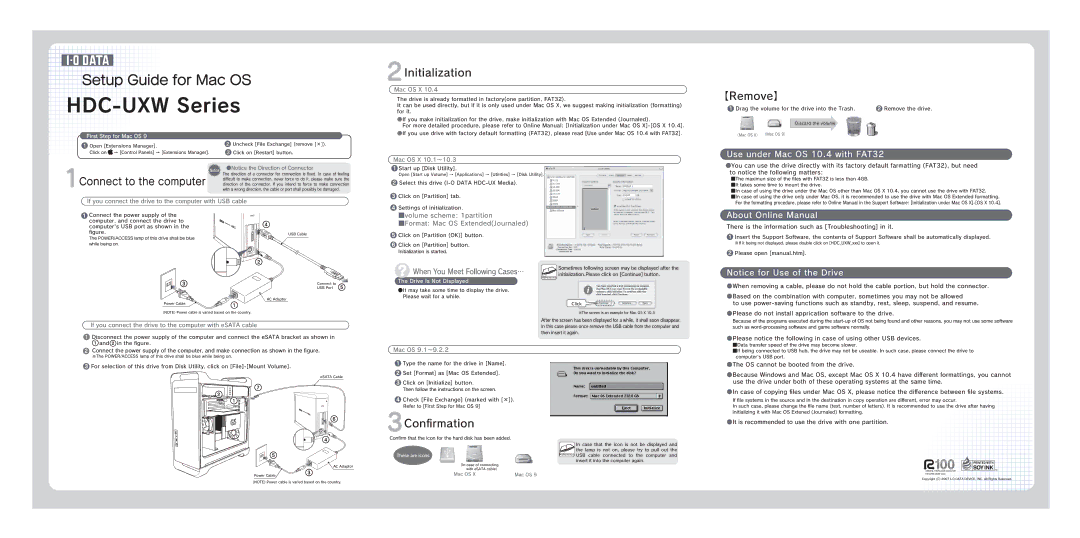
Setup Guide for Mac OS
HDC-UXW Series
First Step for Mac OS 9
2Initialization
Mac OS X 10.4
The drive is already formatted in factory(one partition, FAT32).
It can be used directly, but if it is only used under Mac OS X, we suggest making initialization (formatting) for it.
●If you make initialization for the drive, make initialization with Mac OS Extended (Journaled).
For more detailed procedure, please refer to Online Manual: [Initialization under Mac OS
●If you use drive with factory default formatting (FAT32), please read [Use under Mac OS 10.4 with FAT32].
【Remove】
1 Drag the volume for the drive into the Trash. | 2 Remove the drive. |
Discard the volume
(Mac OS X) (Mac OS 9)
1Open [Extensions Manager].
Click on ![]() → [Control Panels] → [Extensions Manager].
→ [Control Panels] → [Extensions Manager].
1 Notice
Connect to the computer
2Uncheck [File Exchange] (remove [×]).
3 Click on [Restart] button.
●Notice the Direction of Connector
The direction of a connector for connection is fixed. In case of feeling difficult to make connection, never force to do it, please make sure the direction of the connector. If you intend to force to make connection with a wrong direction, the cable or port shall possibly be damaged.
Mac OS X 10.1~10.3
1 Start up [Disk Utility].
Open [Start up Volume] → [Applications] → [Utilities] → [Disk Utility].
2Select this drive
Use under Mac OS 10.4 with FAT32
●You can use the drive directly with its factory default farmatting (FAT32), but need to notice the following matters:
■The maximun size of the files with FAT32 is less than 4GB. ■It takes some time to mount the drive.
■In case of using the drive under the Mac OS other than Mac OS X 10.4, you cannot use the drive with FAT32.
If you connect the drive to the computer with USB cable
3Click on [Partition] tab.
4Settings of initialization.
■In case of using the drive only under Mac OS, it is recommended to use the drive with Mac OS Extended formatting. For the formatting procedure, please refer to Online Manual in the Support Software: [Initialization under Mac OS
1 Connect the power supply of the computer, and connect the drive to computer's USB port as shown in the figure.
4
■volume scheme: 1partition
■Format: Mac OS Extended(Journaled)
About Online Manual
There is the information such as [Troubleshooting] in it.
The POWER/ACCESS lamp of this drive shall be blue while being on.
3
Power Cable | 1 |
|
USB Cable
2
Connect to
USB Port 5
AC Adaptor
5Click on [Partition (OK)] button.
6Click on [Partition] button.
Initialization is started.
 When You Meet Following Cases…
When You Meet Following Cases…
The Drive Is Not Displayed
●It may take some time to display the drive. Please wait for a while.
Reference
Sometimes following screen may be displayed after the initialization.Please click on [Continue] button.
Click
1Insert the Support Software, the contents of Support Software shall be automatically displayed.
※If it being not displayed, please double click on [HDC_UXW_xxx] to open it.
2Please open [manual.htm].
Notice for Use of the Drive
●When removing a cable, please do not hold the cable portion, but hold the connector.
●Based on the combination with computer, sometimes you may not be allowed
to use
(NOTE) Power cable is varied based on the country.
If you connect the drive to the computer with eSATA cable
1Disconnect the power supply of the computer and connect the eSATA bracket as shown in 1 and 2 in the figure.
2Connect the power supply of the computer, and make connection as shown in the figure.
※The POWER/ACCESS lamp of this drive shall be blue while being on.
3For selection of this drive from Disk Utility, click on
※The screen is an example for Mac OS X 10.3
After the screen has been displayed for a while, it shall soon disappear. In this case please once remove the USB cable from the computer and then insert it again.
Mac OS 9.1~9.2.2
1Type the name for the drive in [Name].
●Please do not install apprication software to the drive.
Because of the programs executed during the
●Please notice the following in case of using other USB devices.
■Data transfer speed of the drive may become slower.
■If being connected to USB hub, the drive may not be useable. In such case, please connect the drive to computer's USB port.
●The OS cannot be booted from the drive.
7
2
1 ![]()
5
Power Cable
eSATA Cable
66
4
AC Adaptor
3
2Set [Format] as [Mac OS Extended].
3Click on [Initialize] button.
Then follow the instructions on the screen.
4Check [File Exchange] (marked with [×]).
Refer to [First Step for Mac OS 9]
3Confirmation
Confirm that the icon for the hard disk has been added.
These are icons
(In case of connecting |
|
with eSATA cable) |
|
Mac OS X | Mac OS 9 |
In case that the icon is not be displayed and the lamp is not on, please try to pull out the Reference USB cable connected to the computer and
insert it into the computer again.
●Because Windows and Mac OS, except Mac OS X 10.4 have different formattings, you cannot use the drive under both of these operating systems at the same time.
●In case of copying files under Mac OS X, please notice the difference between file systems.
If file systems in the source and in the destination in copy operation are different, error may occur.
In such case, please change the file name (text, number of letters). It is recommended to use the drive after having initializing it with Mac OS Extened (Journaled) formatting.
●It is recommended to use the drive with one partition.
Utilizing 100%
Copyright (C) 2007
(NOTE) Power cable is varied based on the country.
